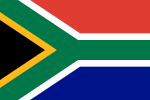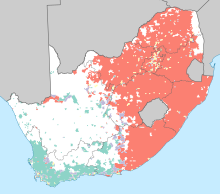
Back Suid-Afrikaanse etniese groepe en kulture Afrikaans الجماعات العرقية في جنوب إفريقيا Arabic Etnias de Sudáfrica Spanish Kelompok etnik di Afrika Selatan ID Grupurile etnice din Africa de Sud Romanian
| Part of a series on the |
| Culture of South Africa |
|---|
 |
| People |
| Cuisine |
| Religion |
| Art |
| Sport |

Ethnic groups in South Africa have a variety of origins. The racial categories introduced by the colonial apartheid regime remain ingrained in South African society[1][2][3][4] with the governing party of South Africa, the African National Congress (ANC) continuing to classify the population as belonging to one of the four colonial-era constructed racial groups: Whites, Indians, Coloureds and Blacks.[4][3]
The ANC government claims that using these categories is essential in order to identify and track the progress of Historically Disadvantaged Individuals (HDI) which are people who, before democratisation and the Constitution of the Republic of South Africa, 1993 (Act No. 200 of 1993), came into operation, were disadvantaged by unfair discrimination on the basis of race under the former colonial apartheid regime.[5][6]
The National Census of 1996 was the 1st comprehensive national census by the ANC government, after the democratic transition. Statistics South Africa (SSA) provides the limited categories based on the classifications of the previous regime by which people must use to classify themselves, including a fifth category of "unspecified/other".[7]
| Category | 1996 | 2001 | 2011 | 2022 | Change |
|---|---|---|---|---|---|
| African | 76,7% | 68,4% | 79,2% | 81,4% | 2,2% |
| Coloured | 10,9% | 7,7% | 8,9% | 8,2% | 0,72% |
| White | 8,9% | 8,3% | 8,9% | 7,3% | 1,6% |
| Asian or Indian | 2,6% | 2,2% | 2,5% | 2,7% | 0,2% |
| Other | No Data | No Data | 0,5% | 0,4% | 0,1% |
| Total population | 40 600 000 | 44 819 778 | 51 770 560 | 62 027 503 | 14,39% |
Racial groups South Africa (2022)
- ^ Rondganger, Lee (6 June 2006). "Being an African makes me who I am". IOL. Retrieved 9 March 2013.
- ^ du Preez, Max (9 March 2011). "Are we all 'coloured'?". News24. Retrieved 9 March 2013.
- ^ a b Posel, Deborah (2001). "What's in a name? Racial categorisations under apartheid and their afterlife" (PDF). Transformation: 50–74. ISSN 0258-7696. Archived from the original (PDF) on 8 November 2006.
- ^ a b Pillay, Kathryn (2019). "Indian Identity in South Africa". The Palgrave Handbook of Ethnicity. pp. 77–92. doi:10.1007/978-981-13-2898-5_9. ISBN 978-981-13-2897-8.
- ^ as per 2021 Guidelines published by the Department of Trade, Industry and Competition in RSA
- ^ Lehohla, Pali (5 May 2005). "Debate over race and censuses not peculiar to SA". Business Report. Archived from the original on 14 August 2007. Retrieved 25 August 2013.
Others pointed out that the repeal of the Population Registration Act in 1991 removed any legal basis for specifying 'race'. The Identification Act of 1997 makes no mention of race. On the other hand, the Employment Equity Act speaks of 'designated groups' being 'black people, women and people with disabilities'. The Act defines 'black' as referring to 'Africans, coloureds and Indians'. Apartheid and the racial identification which underpinned it explicitly linked race with differential access to resources and power. If the post-apartheid order was committed to remedying this, race would have to be included in surveys and censuses, so that progress in eradicating the consequences of apartheid could be measured and monitored. This was the reasoning that led to a 'self-identifying' question about 'race' or 'population group' in both the 1996 and 2001 population censuses, and in Statistics SA's household survey programme.
- ^ Census 2001 Archived 10 August 2007 at the Wayback Machine, Statistics South Africa.
- ^ Primary tables South Africa: Census '96 and 2001 compared (PDF). Statistics South Africa. 2004. pp. 4–5. ISBN 0-621-34320-X. Retrieved 24 November 2015.
- ^ Census in brief (PDF). Statistics South Africa. 2003. ISBN 0-621-34293-9. Retrieved 24 November 2015.
- ^ Census in brief (PDF). Statistics South Africa. 2012. p. 21. ISBN 978-0-621-41388-5.
- ^ Census 2022: Statistical Release P0301.4 Statistics South Africa. Retrieved 16 August 2024